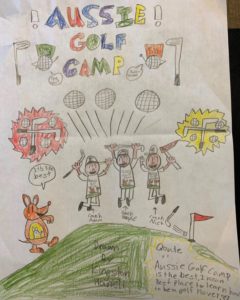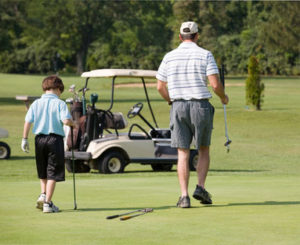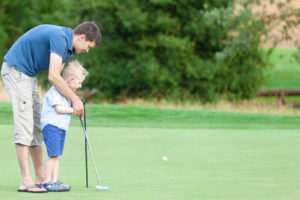 Golf lessons help children learn many important lessons that can benefit them throughout their lives. When they learn to play golf, children learn about courtesy, golf etiquette, and patience while they also are learning the rules and the game. Aussie Kids Golf Academy offers golf lessons, camps, after-school programs, and much more at our four locations throughout the Atlanta Metropolitan area. Our students range from ages three to 17 and are at all playing levels. As we move into 2020, we are excited about both the year ahead and the many programs and opportunities that we offer to kids. We continue to expand our programs to allow more children to explore their love of golf. We are very excited to announce our newest program offering for 2020, which is our Aussie Kids Travel Golf Team. If your kids make the team, they can enjoy the next level of golf as they continue to advance in their game.
Golf lessons help children learn many important lessons that can benefit them throughout their lives. When they learn to play golf, children learn about courtesy, golf etiquette, and patience while they also are learning the rules and the game. Aussie Kids Golf Academy offers golf lessons, camps, after-school programs, and much more at our four locations throughout the Atlanta Metropolitan area. Our students range from ages three to 17 and are at all playing levels. As we move into 2020, we are excited about both the year ahead and the many programs and opportunities that we offer to kids. We continue to expand our programs to allow more children to explore their love of golf. We are very excited to announce our newest program offering for 2020, which is our Aussie Kids Travel Golf Team. If your kids make the team, they can enjoy the next level of golf as they continue to advance in their game.
What is the Aussie Kids Travel Golf Team?
 The Aussie Kids Travel Golf Team will be designed to provide the next level of training for junior golfers. The participants will enjoy an environment filled with fun, competition, knowledge, the application of knowledge, and accelerated growth in the game of golf. By competing on the Aussie Kids Travel Golf Team, junior golfers will receive all of the essential ingredients that young golfers need for continued success and development. The Aussie Kids Travel Golf Team will get to travel to tournaments throughout the area so that young golfers can continue to hone their skills through friendly competition.
The Aussie Kids Travel Golf Team will be designed to provide the next level of training for junior golfers. The participants will enjoy an environment filled with fun, competition, knowledge, the application of knowledge, and accelerated growth in the game of golf. By competing on the Aussie Kids Travel Golf Team, junior golfers will receive all of the essential ingredients that young golfers need for continued success and development. The Aussie Kids Travel Golf Team will get to travel to tournaments throughout the area so that young golfers can continue to hone their skills through friendly competition.
Where will the Aussie Kids Travel Golf Team be based?
It is important to note that the Aussie Kids Travel Golf Team will be based out of our academy location in Buckhead. While this might be a somewhat lengthy drive for some of you, the drive will be worth it for your young golfers. We wanted to make you aware of this new program so that you can have the opportunity to take part in it if you would like. In the future, we also plan to establish a travel golf team for junior golfers from our Johns Creek academy. If your kids are interested in trying out for the Aussie Kids Travel Golf Team, the tryouts will be held at our Miami Circle Academy.
Benefits of participating in the Aussie Kids Travel Golf Team
Kids can derive multiple benefits from competing on the Aussie Kids Travel Golf Team. As members of the team, they can develop close relationships with other young golfers as they learn and grow together. Participating in the travel golf team can allow youth to benefit from advanced instruction and the camaraderie with their teammates. Participating in competitions throughout the area can also help junior golfers to develop a greater respect for other golfers and to show the type of respect and courtesy that is expected of golfers.
Other opportunities at Aussie Kids Golf Academy
If your children are not ready to participate in a travel golf team, Aussie Kids offers many other opportunities at our four locations. If you want golf lessons for your children, Aussie Kids is the best choice. We offer golf lessons for kids of all ages, ranging from three years old to 17. We also offer beginner, intermediate, and advanced programs to benefit junior golfers at all skill levels. Aussie Kids offers private and group golf lessons, golf camps during the winter and summer breaks, and after-school programs that can allow your children to learn the game of golf in a fun and enjoyable environment. When children learn to play golf, they can develop better interpersonal and social skills that can benefit them in school and throughout their lives.
Contact Aussie Kids today to learn more
To learn more about the programs that Aussie Kids offers, contact us at one of our four Atlanta-area locations. You can find more information about our Aussie Kids Travel Golf Team by contacting us today. If you would like to try out for the team, please email or call Elizabeth at elizabeth@aussiekids.com or 404.812.6808 today. When you choose Aussie Kids, you can train with true golf professionals here in Alpharetta or at our academies in Buckhead, John’s Creek, or Cross Creek.




 While it’s easy to tell if a kid has the potential to be a pro in other sports, it’s harder for parents to recognize and foster golf talent in children. Learn the best ways to find out if your child has the potential to succeed and how to support your young golfer’s endeavors to the fullest.
While it’s easy to tell if a kid has the potential to be a pro in other sports, it’s harder for parents to recognize and foster golf talent in children. Learn the best ways to find out if your child has the potential to succeed and how to support your young golfer’s endeavors to the fullest.


 As any golfer knows, choosing the right clubs makes a big difference when it comes time to play. This is especially true for kids. Young players need clubs of the right size and weight for their needs. Equipment that is ill-fitted can create bad habits and swing problems that can be difficult to unlearn later. Children may also get frustrated with the difficulty of the game or their results and not want to keep playing due to ill-fitted equipment.
As any golfer knows, choosing the right clubs makes a big difference when it comes time to play. This is especially true for kids. Young players need clubs of the right size and weight for their needs. Equipment that is ill-fitted can create bad habits and swing problems that can be difficult to unlearn later. Children may also get frustrated with the difficulty of the game or their results and not want to keep playing due to ill-fitted equipment. Golfing can be a great family pastime and wonderful sport for kids, but you’ll need to be sure that your children understand more than just the rules of the game. Etiquette is very important at the course, and you’ll want to take the time to ensure that your children are well-behaved before you start teaching the secrets of a good swing.
Golfing can be a great family pastime and wonderful sport for kids, but you’ll need to be sure that your children understand more than just the rules of the game. Etiquette is very important at the course, and you’ll want to take the time to ensure that your children are well-behaved before you start teaching the secrets of a good swing.
 to putt. By starting good habits at a young age, it will become ingrained in them as adults, and they will be able to drastically improve their game.
to putt. By starting good habits at a young age, it will become ingrained in them as adults, and they will be able to drastically improve their game.


 Our 11,000 square-foot Buckhead Academy has been specifically designed to allow all facets of the game to be practiced in a safe and friendly setting.
Our 11,000 square-foot Buckhead Academy has been specifically designed to allow all facets of the game to be practiced in a safe and friendly setting.